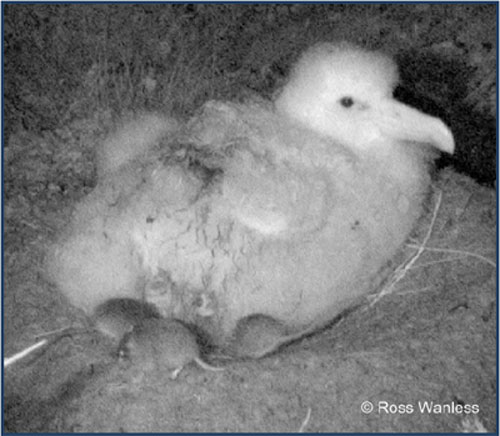Richard Cuthbert of the Royal Society for the Protection of Birds and colleagues report this month in the journal Wildlife Research on the susceptibility to poison bait of the "killer mice" of Gough Island, home of the Critically Endangered Tristan Albatross Diomedea dabbenena, whose chicks the introduced House Mice attack and kill at night.
This and other recent research (see selected reference list below) is preliminary to an eradication attempt in the hopefully near future.
The paper's abstract follows:
"Introduced house mice (Mus musculus) are a serious predator of seabird chicks at Gough Island, resulting in declining populations of several threatened species. This has prompted the preparation of plans to eradicate mice from Gough and other islands. However, relatively little is known about the palatability and efficacy of rodent baits for house mice, as most studies have focussed [sic] on rats (Rattus spp.).
The study's aim was to test the palatability of non-toxic forms of two commercially available rodent pellet bait formulations (Pestoff® 20R and Final®) and a new pellet bait formulated specifically for mouse control (Pestoff® 20M) to house mice on Gough Island. We also tested the efficacy of toxic Pestoff 20R and Final pellets containing 20 and 25 ppm of the anticoagulant toxin brodifacoum.
Five trials with 50 mice housed in individual cages and kept at ambient temperature and light cycles, were undertaken during the year. Palatability of bait pellets was measured over five days and compared with a non-toxic control food (standard ‘rodent pellets' sourced from a pet food supplier). Toxic bait trials were run for 25 days with bait administered at 1, 2 and 10 g for a 24-h period and at 20 g per day for 72 h.
All three baits were highly palatable; however, mice showed the greatest preference for Pestoff 20M and 20R, consuming a larger mass of bait. Estimated oral LD50 values of brodifacoum for Gough mice were 0.44 mg kg-1 and the average time to death following exposure was 5.5 days (range 0-16 days). Two mice (~1% of those tested) survived after apparently ingesting doses of brodifacoum estimated to be 5 and 10 times the oral LD50 values, potentially indicating a lower susceptibility to brodifacoum in some individuals, although subsequent exposure at higher doses resulted in mortality.
The results of this study confirmed that house mice on Gough Island find bait pellets highly palatable and that brodifacoum is an effective toxin with LD50 values and time to death within the same range (0.4 to 0.52 mg kg-1 and 5.2 days) as other studies, indicating no major difference in the susceptibility of Gough mice to this poison.
We recommend that bait manufacturers produce formulations designed to be attractive to mice and consider the use of higher concentrations of brodifacoum to increase the likelihood of all mice obtaining a toxic dose when small quantities of bait are consumed, although higher toxin concentrations must be balanced against the increased risks to non-target species. Eradication operations targeting mice should undertake more than one bait drop to ensure any individuals surviving the initial drop have access to sufficient toxic bait to cause mortality upon second or subsequent exposure.

References:
Angel, A. & Cooper, J. 2006. A review of the impacts of introduced rodents on the islands of Tristan da Cunha and Gough. RSPB Research Report No. 17. 58 pp.
Angel, A, Wanless, R.M. & Cooper, J. 2009. Review of impacts of the introduced House Mouse on islands in the Southern Ocean: are mice equivalent to rats? Biological Invasions 11: 1743-1754.
Cuthbert, R.J., Visser, P., Louw, H. & Ryan, P.G. 2011. Palatability and efficacy of rodent baits for eradicating house mice (Mus musculus) from Gough Island, Tristan da Cunha. Wildlife Research 38: 196-203.
Cuthbert, R.J., Visser, P., Louw, H., Rexer-Huber, K., Parker, G. & Ryan, P G. In press. Preparations for the eradication of mice from Gough Island: results of bait acceptance trials above ground and around cave systems. In: Veitch, C.R., Clout, M.N. & Towns, D.R. (Eds). Island Invasives: Eradication and Management. Gland: World Conservation Union.
Parkes, J. 2008. A feasibility study for the eradication of House Mice from Gough Island. RSPB Research Report No. 34. 51 pp.
Torr, N., Golding, C. & Cuthbert, R.[J.] 2010. Preliminary Operational Plan for Eradicating House Mice from Gough Island. Version 1.0. Sandy: Royal Society for the Protection of Birds. 73 pp.
Wanless, R.M., Ryan, P.G., Altwegg, R., Angel, A., Cooper, J., Cuthbert, R.J. & Hilton, G.M. 2009. From both sides: dire demographic consequences of carnivorous mice and longlining for the Critically Endangered Tristan Albatrosses on Gough Island. Biological Conservation 142: 1710-1718.
Wanless, R.M., Cooper, J., Slabber, M.J. & Ryan, P.G. 2010. Risk assessment of birds foraging terrestrially at Marion and Gough Islands to primary and secondary poisoning by rodenticides. Wildlife Research 37: 524-530.
John Cooper, ACAP Information Officer, 15 July 2011

 English
English  Français
Français  Español
Español